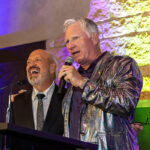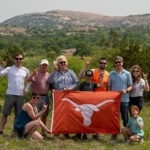Haiti Cherie: A Student’s Journey
If Haiti were a woman, she would have thick skin. She would have to—otherwise she wouldn’t be alive today.
Much of the world’s eyes turned to Haiti on Jan. 12, 2010, when Mother Nature struck a devastating blow: an earthquake that killed tens of thousands.
But that was almost two years ago now. With Haiti no longer in the headlines, the last stories people remember about the nation are of death and disaster. If not those, then tales of money mismanagement and a painfully slow reconstruction process.
Seven of us from UT went to Haiti last summer hoping to find stories of progress and revival. Our ages ranged from 19 to 23, and it was around the time when most of our friends were drinking Lone Stars by the lake and going to Sixth Street every weekend.
Our team arrived at Toussaint Louverture International Airport in Port-au-Prince on the warm evening of June 11.
 From the airport we would immediately depart for the coastal town of Jacmel, three hours away. In Jacmel we would stay in the Cine Institute, Haiti’s only film school.
From the airport we would immediately depart for the coastal town of Jacmel, three hours away. In Jacmel we would stay in the Cine Institute, Haiti’s only film school.
Through the car windows, my eyes tried to take in everything all at once. A faded poster of Barack Obama’s face peeling from the side of a video store. A dusty, gray UNICEF tent. Women ambling on the side of the road balancing baskets and buckets on their heads.
We drove past piles of burning trash, the smell of melting plastic and rotting food wafting into the van. The National Palace remained as broken as the day it fell.
Across the street from the palace was a sea of wrinkly tarp tents where displaced families lived.
On the way out of Port-au-Prince we passed a crowd of people standing outside a white metal fence. A woman named Paula pointed them out, saying it was a funeral.
“Dying is a big thing here,” she commented. “Here we honor our dead.”
The funeral we passed wasn’t a solemn affair; it could have been a wedding party.
A girl in a puffy white dress stared curiously at me from the fence. She wore matching white ribbons in her hair and Mary Janes.
It felt like so much more than the car window separated us.
Jacmel looked like a city painted by its own artists. We wandered our way down the Rue de Commerce, a street famous for its historical Hotel Florita, the FORSAJ art center, and prostitutes. Some of the buildings remained vacant and overrun with foliage, crumbled pieces of wall still dusting on the ground from where the earthquake shook them down.
But the city still enchanted us with its artsy, seaside culture and laid-back people.
We had to leave. Haiti beckoned us to show us some of her deeper wounds, the different ways she was trying heal. And so we followed.
First we went to l’Universite d’Etat d’Haiti, the largest hospital in Haiti, in Port-au-Prince.
A man walked by the hospital’s front gate balancing a casket on his head. Beggars sat on the curb, their eyes following us.
Employees at the hospital protested for the months they hadn’t been paid. There weren’t enough wheelchairs, so they attached wheels to plastic chairs.
The lack of resources was unsettling, but not hopeless.
At the hospital we met doctors from the International Medical Corps teaching Haitian doctors and nurses how to perform CPR.
The idea was that even after the foreign doctors left, the Haitians would be equipped with knowledge to teach their peers, said Dr. Ross Donaldson, head of the program.
We visited GHESKIO, the first HIV/AIDS research and health center in Haiti. Since its humble beginnings in the 1980s, the center has now expanded. We toured the vocational and primary schools, along with the nutrition clinic where mothers infected with HIV/AIDS brought their at-risk babies.
We met 19-year-old Carline, who lived in a tent camp with her mother. She taught music to the primary school students and would become a dear, helpful friend to us during our time at GHESKIO.
 Haiti surprised me. Based on my previous readings, I came with the vague notion I would see a country falling apart and people trapped in a culture of misery.
Haiti surprised me. Based on my previous readings, I came with the vague notion I would see a country falling apart and people trapped in a culture of misery.
But what I saw most was the day-to-day will to survive.
Despite the expected thievery and places we couldn’t go at night, there was also the warmth of people living in one of the most dangerous cities in the world.
People we viewed as having nothing did not act like they were living with nothing. They were rich in compassion.
Back at the hotel, Carline began Facebook chatting with us, and it suddenly struck me how unbroken she was.
I thought of the people who lived in her tent camp, people who had lost their homes, businesses, family and friends. But here they were making this community work and sticking together through it all.
Because no matter the tragedy, the world goes on, so going on too is all anyone can really do.
 And from all the destruction that can occur on one tiny half of an island, there comes the possibility of rebirth.
And from all the destruction that can occur on one tiny half of an island, there comes the possibility of rebirth.
Haiti and her weary soul can rise from the dirt—she can, because if she has the strength to carry on, she can find the strength in her to be reborn into something greater than her past allowed her to be.
My relationship with Haiti felt distant in the beginning. As our departure neared, leaving her felt like leaving a new friend I had just begun to understand.
My anticipated return to Austin was coupled with the feeling of missing out on something, that link to an intimacy I craved to have with Haiti.
And Haiti’s life should not be limited to survival, to basic perseverance. As time passes, I have faith she will also overcome.
I like to think that somewhere in her future people will read stories about triumph and success, not just ones about barely holding on.
If Haiti were a woman, she would be one of the strongest women I have ever met.
Good luck and until we meet again, Haiti cherie.
Photos by Ryan Smith.
Priscilla Totiyapungprasert traveled to Haiti last summer through Students of the World, a nonprofit media production company. She went on a team of seven UT students and four from Haiti’s Cine Institute.
Watch a video from the trip here. A new team of students heading to Haiti will be announced this month.



















No comments
Be the first one to leave a comment.